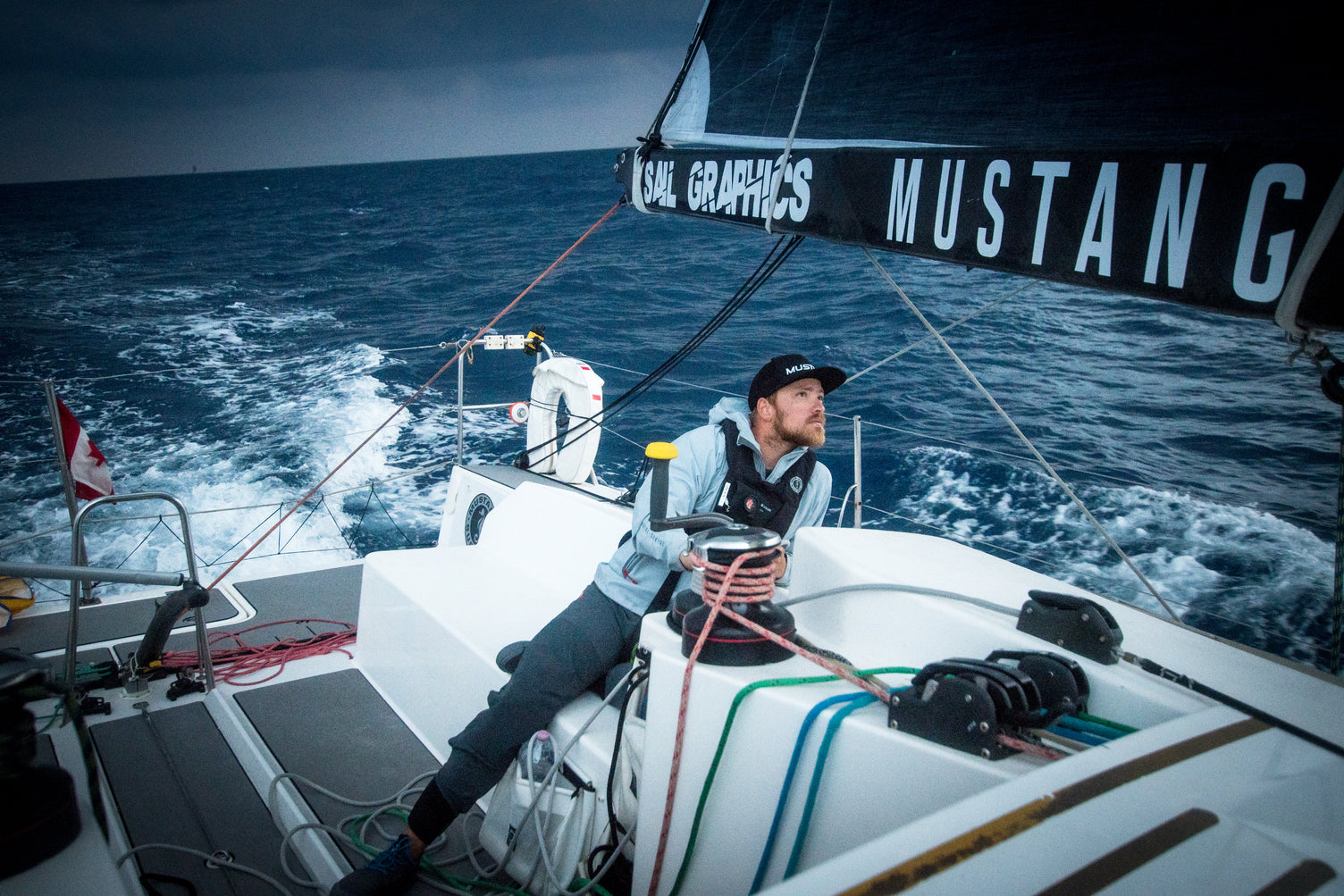Light air and tacking around the south-eastern coast of Sicily separated us from the rest of our fleet at the start. We had some ugly tacks and when our 20+ knot-breeze-tuned battens wouldn’t pop after one tack, we unhappily gauged our lack of progress via a floating piece of garbage.
But we found our Caribbean racing buddies on Jua Kali (Grand Solei 43) and attempted to stick with them as best we could. Boat speeds were depressing offshore, but at least we weren’t stuck bobbing near the coast like some other teams.
By Sunday night we reached the infamous Strait of Messina. Thunderstorms off the coast of Sicily brought favorable enough pressure to get a kite up, and we made it through the Strait before the tidal gate. And this is when things start getting dark.
We emerged from the Strait with a kite up and boy were we excited! Finally, the upwind would be over and we could stretch our legs on a downwind run — or so we thought. It was the 0300-0600 watch and we saw the massive lightning storm looming. So, the choice was ours: take the kite down or run as long as we could straight into the storm.
Luckily we found a happy medium, and cleanly and calmly dropped the kite right before the storm hit. With the full Main and jib, we headed straight into lightning that struck in front of us, accompanied quickly and loudly by thunder. We considered a reef, it was above 20 knots, but by the time we got to that point the wind shut off. Okay, we made it through, or so we thought.
The sky lights up and we see 7 or so boats around us, all pointing different directions. No wind, no steerage, and the digital instruments’ COG was nowhere near what the actual compass said. Then as we were pointing the wrong direction, the wind picked back up and now we were in 30 knots upwind with way too much sail area.
Eventually we got things under control, but not without going in the wrong direction for quite a few miles. It was the first hectic storm we encountered, and it wouldn’t be our last.

By Monday we had thought the upwind racing was behind us, but the Med had a few more challenges in store. We rounded Stromboli by sunrise and continued to beat up the coast of Northern Sicily, praying for our real downwind run to begin.
The predicted favorable weather was late on arrival, and we were either sailing up wind on our ear, or playing with halyards, trim and outhaul to get the boat moving again in no breeze. At night we battled the typical squall — all wind or no wind — wondering if the weather moving off the coast would deliver a better or worse breeze. We hawked AIS to see how our neighboring boats were faring against us, with boat speeds fluctuating from 2 knots to 8 knots based mostly on luck rather than skill.
By next morning we were finally back to downwind sailing, but of course it couldn’t just be an easy ride. I can only tell the story of these next 24 hours from my perspective. Collectively we were all in the same boat, but by Tuesday of the Rolex Middle Sea Race we each had to decide individually what would make or break us.

I was woken up for my 0600-1000 watch earlier than expected by the sensation of a broach… here we go… Kickaboo (A5) was up, we had a full Main and were surfing double digit speeds. I took the tiller and felt the power. Yep, we were on the edge of this sail plan, but next step was reefing and we’d have to take the kite down to do that.
No. We could hold it. We were beautifully making our course around the Favignana mark. A couple of round ups, but we were fine, after two hours driving, I attempted to hand over but that wasn’t happening. It was clear, only Morgen and I could tame this beast.
I finish the watch exhausted, eager to get to sleep. I slept deeply from 1000-1115 not knowing that would be the last lick of rest I would get.

I was awoken early again by another broach and shouts from the deck “Lets get this down!!!” Kickaboo comes down, but not without a fight, and down below reveal her battle wounds: about 7 finger-sized tears around the clew.
As we performed sail surgery, we had the jib up and reef 1, surfing into high teens and still experiencing near knockdowns… it was clear Kickaboo wasn’t going back up for a while. By the time we finished repairs and wooling the kite, it was just in time for my watch to go back on.
The swell was ocean-sized. Breaking rollers and rouge waves crashing abeam. We went back on at 1400 and I made it about an hour and a half back on the tiller before I reached my limit. We just had a clean, albeit nerve-wracking, gybe. But something wasn’t right. Within a 5 minute period we suffered more broaches than I could count. I couldn’t figure out what was wrong because I could barely drive. I couldn’t think, and on the last knockdown when I literally couldn’t move, I knew I couldn’t safely operate this boat anymore.
I screamed to get Morgen on deck to figure shit out while I had a literal breakdown. My mind and body had given up. Morgen took the tiller and I stumbled down below to collapse at the nav station in complete exhaustion. I reached rock bottom, but as my body caught its breath, my nerves soften, I realized that I couldn’t give up. Morgen couldn’t drive for the next 24+ hours. I had no choice. I had to get back on that damn horse.
By sunrise I had logged a total of 13.5 hours driving in a 24 hour period. I felt like a LEGO person, my hand cemented in a gripped position. Death-grip never had a truer meaning. But we had just one more Hell watch to survive, the closest to doom I’ve ever been, and I never felt more alive.

The end. The final mark. The final beating.
We were in full send mode as we came up to Lampedusa. It hadn’t been below 30 knots in a day, and we were certain we were experiencing 40+. We had just logged over 240 NM in the last 24 h, but we still had about 100 NM still to go. In the lee of the island we had a chance to prepare, it was time to head up into the wind, and we didn’t think Reef 2 and the staysail would cut it.
So Reef 3 it was and as we turned towards the wind, we heard and felt what we have never experienced on our Pogo 12.50 Hermes before. No matter the halyard tension, the luff on the main vibrated violently, at such a high frequency that it made a tuning fork from Hell out of our 60 ft rig. You would look at the computer screen and the numbers blurred from the unstoppable shaking.
What you could make out on the screen were a handful of race boats stacked on top of each other in port on AIS. Last chance to bail out before Malta… Hell no.
If all of those other times could be called knockdowns, then this was a knockdown-get-down-brace-for-impact-prepare-to-roll kind of knockdown. You could see and hear this wave for what felt like an eternity. I tried desperately to turn our stern towards the wave, as this foaming-at-the-mouth breaker came for blood.

I threw myself down into the cockpit as this wave broke over us, Hermes was literally on her side, and we surfed down this wave on the edge of going upside down. But she got back up, we got back up, and our hearts beating out of our chest confirmed we were most definitely still alive.
The sun soon rose to reveal a missing windex leg, snapped batten, body bag of water in the reefed main, and a temper tantrum of things scattered throughout the boat below. But we survived the last Hell night, and as darkness disappeared, the sea seemed to soften, and we finally felt close to finish.
The final day of the Rolex Middle Sea Race was near perfect, almost as if it were an apology or consolation prize. Silhouettes of fellow survivors – err competitors – appeared on the horizon, the sun warmed our souls and we soon were able to start stripping our salty Mustang Survival layers.

We had great height on Jackhammer (J121), and slowly began to come down and well in front of them to secure our position through the finish. Crack this baby a little off the wind, and she’ll fly. As we approached the gap between Malta and Comino, we were able to hoist our A3 and send it towards the finish line.
A TP52 just ahead of us were running just a jib, but we postulated that they simply had no kites left. We pulled out a few clean gybes, but watched nervously as Jackhammer put the hammer down and closed the gap. But as we made the entrance through the harbour, dousing the kite right before the roaring swell against the rocks, it was clear we would finish ahead.
A wind shadow had us hectically adjusting sails amongst a crazy-post-douse cockpit, but we made it across the line just fine. Yellowbrick app in hand, Morgen comes up on deck to report that we had provisionally won 3rd Place. The crew exploded. You’d never feel so high, only after such low-lows.
In the end we didn’t actually podium, but for a moment we thought we did, and all the anguish, torture and “near-death” experiences melted away, and it all felt so worth it. And when it comes to handicapped racing, you can either let some algorithms tell you your race was a success or believe that if you truly gave it your all: you won.

Author Meg Reilly is a circumnavigator who runs an international sailing team, Ocean Racers, with her partner Morgen Watson on their Pogo 12.50 Hermes. In 2018, the duo sailed 4,000 NM away from home to compete in the iconic Rolex Middle Sea Race with an Under-35 North American team. Follow the team on their sailing races and adventures around the world @oceanracers on Instagram and Facebook, or check out their website to join the crew.




